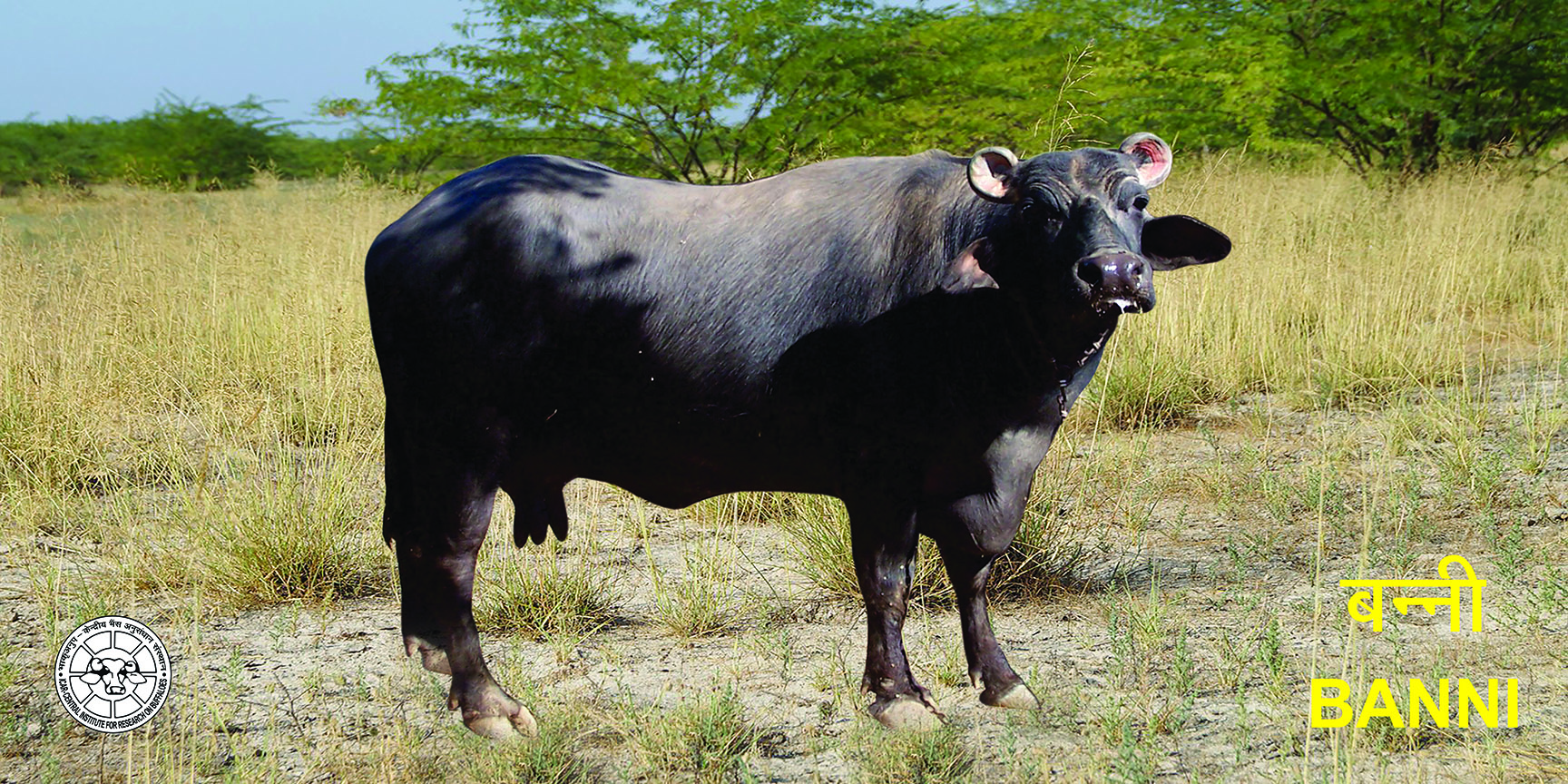Banni
- Origin & Breeding Tract
- Population
- Physical Characteristics
- Biometry
- Production Traits
- Reproduction Traits
- Housing Management & Practices
Banni Buffalo breed was recognized as 11th buffalo breed of India by Breed Registration Committee, ICAR, New Delhi.The breed is originated from the Banni area of kachchh, which is a part of Kachchh district of Gujarat. It is located about 690 24’ E 230 42’N axis. Purebred animals prevalent in Bhuj, Nakhatrana, Anjar, Bhaahau, Lakhpat, Rapar and Khavda talukas, are heavily size with typical double and vertical coiling of the horn.The total area of Banni grassland is about 3847 sq. km. The inherently saline soil, deposited by long lost river systems, is naturally suited for nutritious grasses. There are more than 20 species of grasses and 20 species of shrubs found in the Banni pasture land. The rain water harvesting system in the region is known as “Khuira” , which is unique system of harvesting and conservation of water in the region.
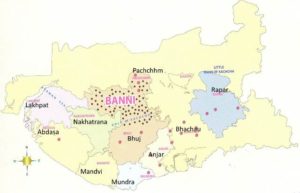
The “sui-genesis” germplasm of kachchh i.e. “Banni buffaloes” are maintained by maldharis under typically and locally adapted extensive production system in its breeding tract. The breed is very hardy, well adapted to harsh climatic conditions. The performance recorded under field conditions shows the potentiality of the animals, which is regular in breeding and have high milk production potential. Banni buffalo known for high productivity, hardiness, reared under extensive production system, thrives on grasses available in the Banni grass land through night grazing and only source of livelihood for landless maldharis.In Banni, Maldharis adopted animal husbandry exclusive livelihood approach, they have been invented locally adapted extensive production system to reduce the cost of production. Banni buffaloes are trained to typical grazing on banni grass land during night and come to the villages in the morning for giving milk. This traditional system of buffalo rearing has been adapted to avoid the heat stress and high temperature of the day.
contributed by K.P Singh and Sunesh
The total population of Banni buffalo in the state is about 5.25 lakhs which is highest in Kachchh (1,68,938) followed by Sabarkantha (78,622), Surendranagar (55,588), Kheda (39,710) and Banaskantha (35,142) .The animals of this breed were also taken to the adjoining state i.e. Madhya Pradesh, Maharashtra and Rajasthan by livestock breeders.
District-wise Banni Buffalo Population in Gujarat state
| Sr No | District | Population | Sr No | District | Population |
| 1 | Kachchh | 1,68,938 | 13 | Anand | 21,911 |
| 2 | Banaskantna | 35,142 | 14 | Kheda | 39,710 |
| 3 | Patan | 12,261 | 15 | Panchmahal | 8,436 |
| 4 | Mehsana | 8,449 | 16 | Dahod | 2,507 |
| 5 | Sabarkantha | 78,622 | 17 | Vadodara | 14,281 |
| 6 | Gandhinagar | 18,661 | 18 | Narmada | 1,214 |
| 7 | Ahmedabad | 4,168 | 19 | Bharuch | 4,311 |
| 8 | Surendranagar | 55,588 | 20 | Surat | 11,234 |
| 9 | Rajkot | 17,585 | 21 | Navsari | 1,523 |
| 10 | Porbandar | 606 | 22 | Valsad | 3,696 |
| 11 | Junagadh | 7,890 | 23 | Tapi | 6,386 |
| 12 | Bhavnagar | 1,896 | 24 | Dang | Nil |
| Gujarat State | 5,25,015 | ||||
Some of the important characteristics is described as follows: –
| Body color | The body coat colour is black (90.09%) and copper (9.90%), whereas muzzle and eyelids are either black or brown | |
| Horns | Horns orientation is vertical, inverted double coiling in 31.20% and vertical, inverted single coiling in 68.80% animals. | |
| Marking | ||
| Eye | Eyes are prominent black and bright. | |
| Tail | The colour pattern of the switch of tail comprises (67.35%) white and (32.65%) black and length of the tail is 88.39+-0.48cm. | |
| Body | Medium to large, compact and generally covered with hairs.Dewlap is absent and naval flap is medium. | |
| Head | Wide with slight depression in the middle and no slope towards base of the horns. | |
| Face | Comparatively elongated and straight with wide muzzle. | |
| Neck | Medium and thin without skin folds over the region. | |
| Ear | Ear orientation is horizontal in majority of animals and length of ear is 29.30+-0.08cm. | |
| Limbs | ||
| Skin | Soft, thin and generally black in colour but few animals are also observed possessing copper/albino colour (6-7%). | |
| Udder | Well developed, round in shape and squarely placed. The hind and fore quarters are uniformly well developed, whereas typically whole udder looks like four equal divisions with teats well attached to each quarter. | |
| Teats | Majority of animals have conical teats with round and pointed tips. |
contributed by K.P Singh and Sunesh
The mean values of body weight at birth, 6, 9,12,18,24 months and at first calving reported by various workers are presented below.
| Stage | Mean +- S.E(Kg) | Mean +- S.E(Kg) |
| At Birth | ||
| 3 months | ||
| 6 months | ||
| 9 months | ||
| 12 months | ||
| 18 months | ||
| 24 months | ||
| At first calving |
Morphological Characteristics
Various values of morphological traits of Banni buffaloes like body length, height at withers, heart girth and adult weight are given in the following table.
| characteristics | Sex | Mean +- S.E(Kg) |
| Body Length(cm) | Male
Female |
143.67+ 2.13 (18)
153.01+ 0.57 (384) |
| Height at withers(c) | Male
Female |
137.64+ 1.89 (18)
137.25+0.38 (388) |
| Hearth Girth(cm) | Male
Female |
214.03+ 5.10 (18)
203.74+0.6 (386) |
| Birth Weight(Kg) | Male
Female |
|
| Adult weight(Kg) | Male
Female |
The production performance of Banni buffalo was evaluated under In-Situ Conservation Project implemented during 11th five year plan by S.D. Agricultural University, Sardarkrushinagar with the participation of maldharis in Banni area of Kachchh.
Average production performance of Banni buffalo under field conditions
| Traits | No. of Observations | Mean+ S.E |
| Average lactation length(days) | 84 | 300.96 + 4.43 |
| Average lactation milk yield (kg) | 84 | 2857.21 + 89.76 |
| Average daily milk yield (kg) | 1207 | 11.53 + 0.07 |
| Peak milk yield (kg) | 206 | 14.87 + 0.21 |
| Average Fat% | 545 | 6.65 + 0.11 |
| Average SNF% | 606 | 8.79 + 0.01 |
contributed by K.P Singh and Sunesh
Reproduction Traits
- Male
| Traits | Values |
| Age at puberty (months) | |
| Age at first training(months) | |
| Age at first ejaculation(months) | |
| Age at first mating(months) |
- Female
| Traits | No. of Animals | Mean+S.E |
| Age at puberty (months) | ||
| Age at First Calving (months) | 294 | 40.28+-0.25 |
| Service Period(days) | 100 | 85.64+ 4.23 |
| Dry Period(days) | 44 | 81.77+ 4.41 |
| Calving Interval(days) | 44 | 372.43+ 3.97 |
| Estrous Cycle Length(days) | ||
| Estrousn Duration (hrs) | ||
| Gestation Length (days) | 44 | 301.0+ 2.07 |
(Reproduction traits of Banni buffalo under field conditions)
These findings indicated that this breed have better reproductive ability, which shows that it have ability to produce a calf almost every year.
contributed by K.P Singh and Sunesh
Management practices
The animals are reared under night grazing system, whereas young calves kept in the enclosure. During the milking all the animals remains untie, where owners tied either fore legs or hind legs, which is locally called as “Nunjan” and “Vangh” respectively. The concentrate offered to milch and advance pregnant animals and calves in a beg called as “Pavro” is very ideal method of concentrate feeding without any wastage. The system of rearing these animals may called as “Banni Buffalo Pastoral Production System” , where animals do not provide any shelter and have common watering facilities either in the ponds or common water trough. The maldharis of kachchh have adopted different buffalo rearing system, which is summarized here as under.
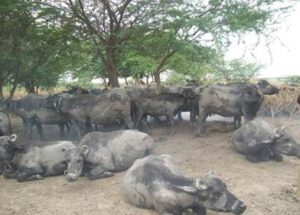
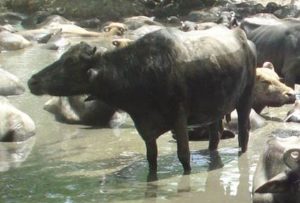
Extensive pastoral production system
This system is adopted in the Nakhatrana, Hajipeer area (Nani Banni area or west Banni area)), where buffaloes are taken to the forest in the evening, they stay overnight for grazing and come back to the village in the morning. Some times owners does not go with the animals, and buffalo follow the routine on their own. All the animals depends only on grazing in the forest, while only milch animals provides concentrate mixture during milking.
Semi – intensive pastoral production system
The animals are tied under the tree shades during day hours and offered green / dry fodder. The concentrate mixture is offered to the milch animals only during milking. However, all the animals taken for grazing during night hours in the forest. This system is followed in the east Banni area / greater Banni area, which includes Khawda, Bhirandiyara, Dhori, Sumrasar area. The maldharis adopted traditional system of hand milking only either once or twice in a day, depends upon the marketing facilities. The concentrate mixture is offered before milking to the milch animals only in the beg, which is hang on its head .
Feeding Mangement
In Banni area, buffaloes are maintained under extensive production system and grazed in Banni grassland during night. Maldharis offered supplementary feeding while milking through traditional system. For supplementary feeding generally homemade concentrate provide to lactating animals as follows:
Cotton Seed Cake 25% + Wheat bran 75% @ 3 – 4 kg/ animal or
Ground-nut Cake 35% + Wheat bran 65% @ 4 – 5 kg/animal
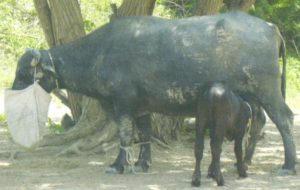
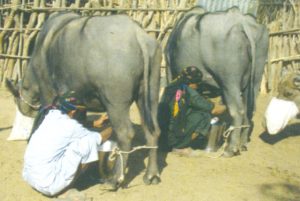
During scarcity period (summer) dry fodder/ grasses supplied to livestock owners by the state government through Banni Development Scheme and maldharis also purchased cotton holls ( locally called “thaliya”) for feeding their animals in summer @ 4 -5 kg/day /animal after 3- 4 hours soaking in water.
Calf Mangement
All the calves keep in the separate enclosure built up of wooden / shrubs boundary in the tree shades remains open, to protect them from the heat / cold / predators. These calves allow for suckling simultaneously before and after milking, whereas some owners allow for suckling after milking only. Young calves do not allow for grazing in the forest, however they fed concentrate mixture similar as fed to milch buffaloes as ad.lib.
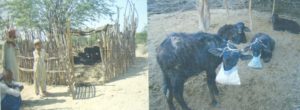
Young calves keeping in the separate wooden enclosure, which is surrounding of the tree without any roof, to protect from the high / low temperature and wild animals.
contributed by K.P Singh and Sunesh

